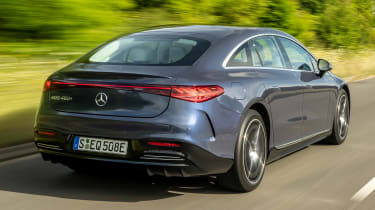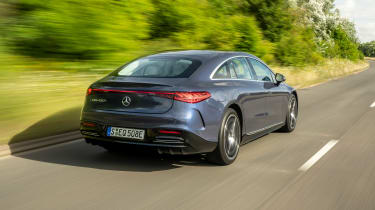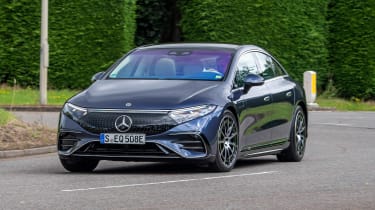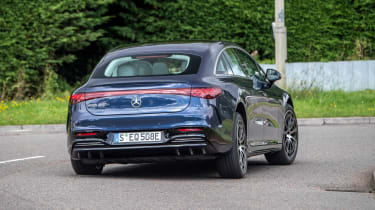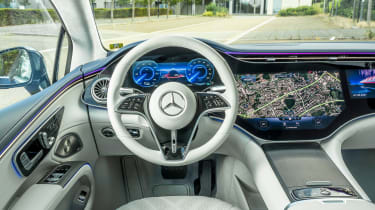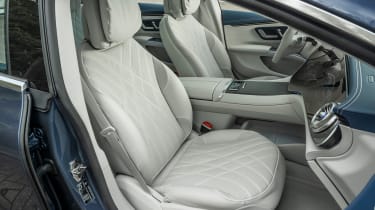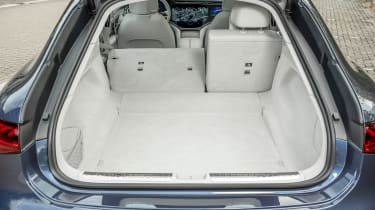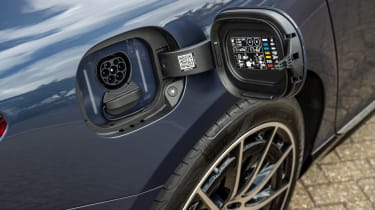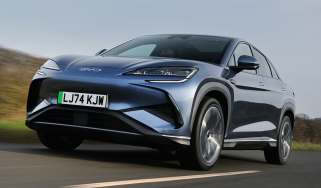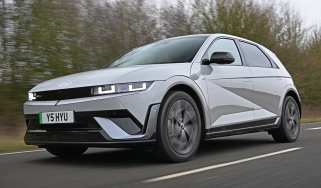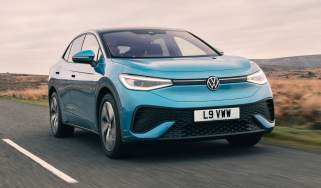Mercedes EQS hatchback review
"The Mercedes EQS is the first truly luxurious EV with an impressive range, but its ride comfort can be jarring"
Pros
- Incredible range
- Sumptuous interior
- Next-generation technology
Cons
- Slightly firm ride
- Expensive
- Polarising design
Most manufacturers target between 200 and 300 miles for their big battery electric vehicles. Indeed, for many drivers, this seems like the sweet spot needed to satisfy the occasional long trip or regular motorway journey. But Mercedes thinks differently, and by using the latest technology and cutting-edge aerodynamics, has launched one of the very first 400-mile-plus EVs: the Mercedes EQS.
Mercedes plans to offer an EV in every segment by 2025, before becoming an all-electric brand by 2030, and the EQS is a clear signal of its intent to be a dominant force. While other models such as the Porsche Taycan Turbo S and Tesla Model S Plaid may be faster, nothing comes close to matching its luxury or opulence. A new AMG-tuned EQS 53 model provides the closest alternative to those cars, with 649bhp and a sportier suspension tune.
Designed as an electric alternative to Merc's venerable S-Class, the EQS is not only whisper quiet and smooth riding, it also boasts exceptional interior materials and build quality. Furthermore, the optional, 1.4-metre wide 'Hyperscreen' infotainment display represents another substantial leap forwards for in-car technology from the traditional manufacturers, in an effort to keep up with Tesla's hardware and software.
More reviews
In-depth reviews
To fit its VIP transport brief, the EQS is also spacious, even if it can't quite match the S-Class for rear headroom. Legroom is plentiful, and its 610-litre hatchback boot is also surprisingly practical, giving it more cargo space than the Mercedes EQC SUV. Folding down the rear seats expands storage to 1,770 litres, but we'd probably draw the line at trying to load muddy bikes or sports gear into a pristine EQS. If you want to do that, the EQS SUV is probably a better pick, with similar tech to the hatchback, but in a taller and more rugged package.
From launch, two versions were offered, and now the Mercedes-AMG EQS 53 has joined the line-up. The EQS 450+ gets 324bhp and rear-wheel drive, along with a 107.8kWh battery for a 453-mile driving range. UK buyers aren't currently offered the 580 4MATIC so those after a bit more punch should look to the EQS 53; it also gets four-wheel drive and Mercedes’ vast Hyperscreen infotainment set-up, plus all the trappings we’ve come to expect from AMG models. It has a range-topping price too: over £150,000.
The EQS’ battery is around double the size of more humble electric cars’, and having such a large battery means charging using a three-phase 11kW wallbox takes around 10.5 hours. It can also charge at up to 200kW at compatible ultra-rapid chargers, with a top-up from 10 to 80% taking around half-an-hour.
While the EQS will likely draw comparisons from the Porsche Taycan and Tesla Model S, in reality it's in a different class with no real direct rivals for the time being. The Porsche and Tesla are smaller and more engaging to drive, but the comfort, luxury and space on offer in the EQS make it the world's first luxury electric car for eco-conscious CEOs.
MPG, running costs & CO2
While some manufacturers are content to give their all-electric superminis and crossovers a short driving range in the name of affordable urban driving, the same wouldn't do for the EQS. This is a flagship model, designed to spend much of its life on the motorways and autobahns, bridging the distance between cities and carrying VIPs from their offices to their weekend retreats sustainably.
A 453-mile range for the rear-wheel drive 450+ version makes the EQS one of the first models capable of beating the Tesla Model S for driving distance between charges. The figure drops slightly if you choose a version with bigger alloy wheels and more equipment, while the EQS 53 manages up to 377 miles between stops. The Model S Long Range can manage just more than 400 miles, while the Porsche Taycan can top 300 miles.
Part of the reason for the EQS' long range is its slippery shape, with a drag coefficient claimed to be the lowest of any production car to date. It also has a huge 107.8kWh battery, which has more than double the capacity found in a Nissan Leaf or a Renault ZOE. A smaller 90kWh version of the EQS is also going to be available later on. Mercedes’ future saloons will all look this sleek, with the classic three-box shape considered not aerodynamic enough.
Both versions of the EQS will take around 10.5 hours to fully charge using an 11kW home wallbox, provided a three-phase power supply is available. Away from the home or office, the EQS can charge at up to 200kW using an ultra-rapid charger, providing a top-up from 10 to 80% in as little as 31 minutes.
The EQS should appeal to the business buyers who account for most Mercedes S-Class sales, thanks to its very low Benefit-in-Kind bands. It will also be exempt from tariffs in low-emissions zones, which could represent a significant cost-saving for operators driving in and out of cities like London. The EQS is also exempt from VED (road tax), but its list price is too high for it to qualify for the plug-in car grant.
Engines, drive & performance
It's likely more versions will arrive in future, but currently there are two levels of EQS performance for buyers to pick from. The 'sensible' EQS 450+ has a single 324bhp electric motor for the rear wheels, getting the 2.4-tonne luxury saloon from 0-62mph in 6.2 seconds.
If that's too stately, the Mercedes-AMG EQS 53 4MATIC+ instead has an electric motor for each axle, giving it 649bhp and a 0-62mph dash of 3.8 seconds. This doesn't make it as ballistic as the Porsche Taycan or Model S Plaid, but then the EQS is designed with comfort in mind after all.
The EQS 53 clearly gets up to speed much quicker than the 450+, but the way both cars feel when accelerating is actually quite similar. And there’s no brawny engine noise to elevate the AMG, either. But there are differences in the chassis set-up, with the AMG feeling much more agile and lighter on its feet. The EQS 53 no longer feels like the 2.5-tonne car it is.
While there's no denying the EQS is a bruiser of a car, Mercedes has fitted rear-axle steering as standard. This can normally turn the rear wheels by up to 4.5 degrees, but our test car was fitted with an optional version increasing this to 10 degrees. Thus equipped, the EQS has a turning circle only 40cm larger than a Renault ZOE city car, and it feels much more nimble than you would expect given its size. As if to emphasise its manoeuvrability, the steering is also rather light.
The EQS also features 'intelligent recuperation', using cameras and its on-board computers to decide when to use the electric motors to decelerate the car and feed energy back into the battery. While it can be caught out, this works well in most situations, automatically slowing the car for roundabouts and the traffic ahead. During our drive we barely touched the brake pedal, which is a further plus given that we're still not huge fans of the pedal feel in Mercedes' large EVs.
Interior & comfort
The Mercedes S-Class is renowned for its sublime ride comfort, so the EQS has a lot to live up to. Sadly, while it's a very comfortable car for the vast majority of the time, it doesn't have the feel of floating just above the road that some Mercedes buyers may want, and its air suspension is occasionally upset by deep potholes.
Refinement really impresses, though, with an almost silent interior ambience at lower speeds. Head onto the motorway and there's just a hint of wind noise from around the A-pillars, making for a relaxing experience for the driver and passengers.
Perhaps an even bigger wow factor is the interior design itself, with a stunning 'Hyperscreen' infotainment set-up as its centrepiece. This is standard on the EQS 53, but is an option costing around £8,000 on other versions. Measuring 1.41-metres wide, it consists of a huge piece of curved glass with a 12.3-inch driver's display, a 17.7-inch infotainment screen and a 12.3-inch screen for the passenger. This provides an exceptional user experience, controlling everything from entertainment to the seats and safety systems. The passenger display shows a decorative image when the seat is empty, and activates when it senses a front occupant. Fingers crossed it never malfunctions, or else you may have to have the whole dashboard replaced.
Mercedes has also worked hard on making the systems simple to use, so there's a home button to get back to the main interface, and a favourites bar that quickly learns your most-used features. Mercedes calls this a 'zero-layer' system, designed to avoid having to dig through menus and sub-menus. A driver attention camera will also detect if the driver is becoming too distracted by all the information on offer. To help users avoid having to prod the screen at all, the "Hey Mercedes" voice assistant has also been improved and can even be used by rear passengers. A rear-seat entertainment system is also offered, with a pair of 11.6-inch displays with the option to share content around the car.
Interior materials are class-leading, no matter where you look inside the EQS. It's solidly built too, and while the layout of controls will be familiar to Mercedes drivers, everything has been adapted for this flagship EV to feel exclusive.
Practicality & boot space
The Mercedes EQS is a huge car, measuring 5.22 metres long and 1.93 metres wide, so it should come as no surprise that interior space is generous. Legroom is no issue for tall adults front or rear, but the sleek roofline does mean there's no where near as much headroom as you'll find in an S-Class; taller passengers will have to slouch. That said, the EQS does benefit from a completely flat floor thanks to its lack of a transmission tunnel, providing lots of space in the footwell.
Unlike the Tesla Model S, Porsche Taycan and Audi e-tron GT, the EQS doesn't have a 'frunk' storage area under its bonnet, but makes up for it somewhat with a huge 610-litre boot. It's also easier to access than a few of its rivals, thanks to a hatchback boot that creates a large loading aperture. Fold down the back seats and space increases to an estate car-like 1,770 litres.
Reliability & safety
Theoretically, a powertrain using a battery and electric motors should be simpler and more robust than a combustion engine or plug-in hybrid set-up. But this is bleeding-edge technology for Mercedes, so only time will tell just how reliable the EQS will be. Unfortunately, Mercedes slipped 10 places in our 2022 Driver Power owner satisfaction survey, yo-yoing from 28th in 2020 and 13th in 2021, to 23rd this time around. Not the most encouraging news for would-be EQS owners.
Of the owners who responded, 27% reported a fault within the first year of driving, compared with 44% for Tesla, and just under 29% of Porsche customers. But that's only half the story – Mercedes owners thought their cars were expensive to run and didn't offer the level of quality they thought they'd paid for. Ride and handling – as well as comfort – took a bit of a battering too. Practicality was a plus point.
However, along with Volvo, Mercedes is one of the leading lights for safety tech, and the flagship EQS is at the forefront of its programme. A five-star Euro NCAP result is the reward, with an impressive 96% score in the adult occupant category. Active Steering Assist can keep the Mercedes in its lane on the motorway at up to 74mph, and the EQS can also help the driver change lanes when safe to do so. It's also bristling with anti-collision sensors, to avoid a bump while driving and parking. Try to exit the EQS as a bicycle or car approaches, and an exit warning will trigger.
At up to 37mph, Mercedes' Drive Pilot can even allow Level 3 autonomous driving, with hands off the steering wheel. At least it can in some markets, but this technology isn't yet permitted by UK regulations, so won't be activated for the time being. If it is, it can allow drivers to relax or check emails in slow-moving traffic.
Which Is Best?
Cheapest
- NameEQS 350 215kW AMG Line Premium 96kWh 4dr Auto
- Gearbox typeAuto
- RRP£99,620
Most Economical
- NameEQS 450+ 265kW AMG Line Premium 118kWh 4dr Auto
- Gearbox typeAuto
- RRP£112,395
Fastest
- NameEQS 450+ 265kW AMG Line Premium 118kWh 4dr Auto
- Gearbox typeAuto
- RRP£112,395



